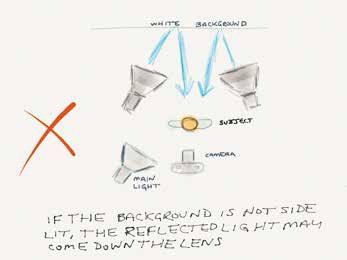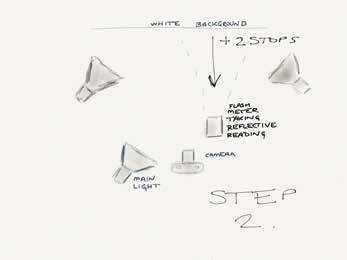articles/Lighting/lmsw-page2
Lighting Masterclass by Stuart Wood - part 2 of 1 2 3
by Stuart Wood Published 01/04/2014

So this will work anywhere in the known universe (and yes that includes your small studio) with the possible exception of the middle of a black hole, where fortunately we do not tend to perform many 'baby and bump' shoots these days.
Talking of the laws of physics and how we have chosen to measure them, you will now need two things.
1. A basic understanding of Ansell Adams Zone System and how to render an accurate exposure without simply relying on a few little dots in your viewfinder.
2. A flash meter that can take incident and reflective readings,
which compared to your other gear can be acquired reasonably inexpensively.
If you have not already got both of these items, then come on guys, are we taking our craft seriously or not, because surely to be better photographers, we do need the proper tools to hand?
Ok, straight forward so far.
When we look at white in the zone system (or whatever measurement scale you care to use) which is the point where no detail is recorded thus rendering pure white, we notice that this occurs 2 stops above mid grey.
As mid grey is our optimum exposure for our main subject, all we then have to do is expose for our main subject and get a fixed aperture (eg f11) and then make our white background 2 stops brighter than our subject (eg f22) to achieve a pure white. (Don't worry I will explain this in more detail shortly)
If you now care to take another look at my featured images that I took (blimey three years ago, where did that go!) and used together as a Radio Times pull out cover. (Great when you get a cover with them as you get an invite to the covers party at Claridges with free bar and wall-to-wall celebs!)

I hope you admire the lovely pure white background that I achieved?
Before anyone suggests it, the pictures are not 'cut outs' but images straight from camera and put together later at the magazine and the white background is genuine. I am able to do this not because I am talented or intelligent, (no comedic comments please!) but because over the years I have performed this procedure billions of times...well at least it feels like I have.
Ok now we need to understand the difference (if you don't YouTube it) between a reflective and incident light reading.
Really simple, we light our main subject and take an 'incident' light reading. (eg again let's say f11) so we place our light meter next to our subject, point the little white bubble at the light and read the light that is falling onto it.
Easy!
We then independently light our white background, which is hopefully positioned well away from our subject, to give a 'reflective' reading of + 2 stops. We stand where our camera is and point our meter at the background until it gives a reading of 2 stops over our main reading. So if our earlier example is f11 for our subject, we need the reflective reading from the background to read an even f22 reflected back.
That's it! Dead simple.
Do not let anyone else tell you otherwise and go and get all confused on us, as it really is that easy.
So why do we take an incident light reading from our subject, but then take a reflective light reading from our backgrounds?
Ok, the most accurate way to get the optimum exposure for our main subject is to read the light that is actually falling onto that subject, so we take our 'incident' reading as previously described.
As our light meters only see mid-grey and will try and convert everything that they see into their favourite mid-grey, they can get very confused if, for example, we take a 'reflective' reading, (ie point our meter at the subject and read the light 'reflecting' from it) if our subject happens to be wearing either very bright or very dark clothes.
So we take our 'incident' reading next to our subject knowing that measuring purely the light falling onto our chosen subject, will give us our optimum exposure and what we will then need to set our lens aperture to.
So now we have established our fixed point, (the camera aperture), we now light our background and take a 'reflective' reading because we are not particularly interested in what light is falling onto our background, as we are now only concerned with the light 'reflecting' from it and if we manage to light it evenly 2 stops over our camera aperture, (as per Mr Adams Zone System) we will attain a lovely, clean and beautiful pure white!
Please Note:
There is more than one page for this Article.
You are currently on page 2
- Lighting Masterclass by Stuart Wood page 1
- Lighting Masterclass by Stuart Wood page 2
- Lighting Masterclass by Stuart Wood page 3
1st Published 01/04/2014
last update 09/12/2022 14:56:04
More Lighting Articles
There are 0 days to get ready for The Society of Photographers Convention and Trade Show at The Novotel London West, Hammersmith ...
which starts on Wednesday 15th January 2025





